You start strolling down the street and notice people walking, talking, and even some children playing. As you look around you notice the houses and buildings are Victorian-era styled with dormers, towers, and decorative railings. Lewisburg does not want to change for a new age look; the people would much rather preserve the history.
On the right-hand side is the First National Bank, a structure with stone arches above the second floor windows. You keep walking and turn right onto 3rd Street at the end of the block. Looking down the street, there are many enticing structures. A small stone structure from 1869 is labeled ‘Lewisburg Opera House’;
it burned to the ground in 1908. The collection of bricks is all that still remains. A little further down the road is the Beaver Memorial United Methodist Church, which is a large pointed structure, almost like a needle coming out of the ground. The street also has a little post with a box on it, which is filled with books. It’s a great opportunity to pick one up and read it, or even just leave a book for others to enjoy.
You can also see people reading a poem off a board that’s part of the historical Bucknell Poetry Path. This is one of the ten poems along the scenic route through Lewisburg. As you continue walking down 3rd Street, you stop and turn for moment.
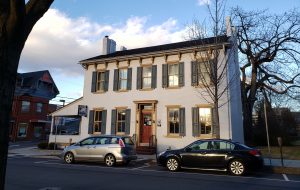
Standing on the sidewalk looking across the street, you see a white house. It looks like it fits in with the rest of the homes in Lewisburg, but you notice a small sign perpendicular to the front and cross the street to get a closer look. It is mostly white, matching the house it is attached to and reads: “Comics Metropolis.” What kind of comic book shop could be inside a home?
Turning the knob of the front door, you step through two doorways, then find yourself in a foyer with the ability to go left or right. Say you wander to the left side of the house first.
https://www.thinglink.com/scene/1167315841511849985
There are miniature figurines gracing the windowsills and shelvetops with sizes ranging from a baby carrot to as large as your torso.
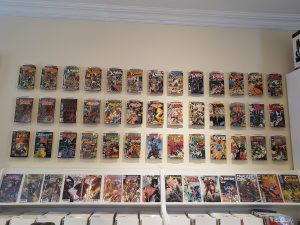
Moving further into this half of the store, you see another room in the back. It’ divided into different segments of board games, small kits, individual primed minifigures, paints to finish said figures, and multitudes of instructional manuals and how-to books. With all those kits and paints and how-to’s, this room feels like a lab where one would start a journey of creating something wonderful.
Leaving the room, you go back through the minifigures, then the foyer, to find yourself in the other half of the store. On an island are comics galore. It’s fully stocked and takes up most of the space in the room. It’s organized alphabetically by title, those written in 2000 to the present up top and 1999 or prior in pull-out drawers.
The island is bordered on two sides by shelves full of books towering to the ceiling, and turning the corner around the back of the island you find a door to yet another room. Curiously, there is a group of people around a large table when the rest of the store is virtually devoid of people minus the owners. Filled with sunlight, the room might be spacious if it weren’t for the table. One man greets you at the door and asks how you’re doing.
“Good,” you reply, “What game is this?”
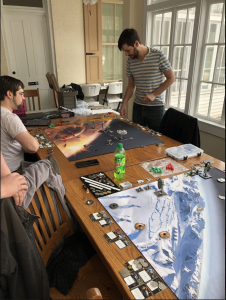
It’s Star Wars X-Wing, and their group plays here every Saturday morning. This room is where people gather, much like the dining room it used to be as part of the original house, whether to play organized games or to start interacting with whatever new purchase a customer has made.
Turning back to the shop, you see a fireplace, complete with collectibles adorning the mantle, much like the centerpiece in some of the homes you’ve been a guest in over the years. The fireplace as a focal point isn’t a new concept, as another lover of literature “converted a former laundry into a one-room English-language bookshop and lending library, whose centerpiece was the laundry’s old fireplace” back in 1919 in Paris, France (Buzbee 152). This fireplace has a sort of grand old look to it, fitting with the rest of the house.
Moving to the right to complete the circle, at the front edge of the store sits a counter, complete with all the supplies needed to run a comic book business, including a computer. Though it had once been a living room, now you see this bit resembling something closer to an office with the front workspace and all the neat filing done up in alphabetical order. It’s no surprise that Laura and Albert spend a significant amount of time here.
In fact, Laura spends plenty of time in the shop because she lives upstairs. Returning to the main foyer, you see the stairs leading up to the rest of the house. Laura thinks of the house’s history and the people who must have lived here years ago every time she walks up those stairs. Based on the layout upstairs, one room must have been for a servant, and there are various call buttons and a back staircase that support this theory, so the family was probably well-off.
The house itself was originally built in 1850 and a butternut tree stands strong in the backyard, over a hundred years old. Laura has become fond of the tree and named her “Victoria” for the era the tree and house came to exist in. Leaving the store and crossing the street, you see a pillar. Left over from the Lewisburg Opera House, built in 1869 but burned to the ground in 1908, it is yet another reminder of the strong history of the town and the stories behind what it is today.
Turning back to face Comics Metropolis, you realize there truly is an emphasis on the story of comics much as Lewisburg emphasizes its own story. Comics, like buildings, aren’t a stand-alone product, but as a form of literature, they bring other worlds to life and each reader has a personal connection with the fantasy. Though the two halves of the store are distinctly separate in terms of their stock, there is so much crossover as the left side truly allows the comic content to jump off the page and into our homes more than any other type of literature.
You’re interested in everything you’ve seen and learned so far, especially the fact that Laura lives upstairs and is pretty much on-site all the time. You decide to ask her how she got around to opening this bookstore.
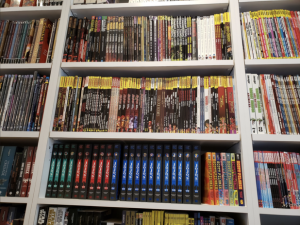
Laura has 4 degrees in English. She changed her emphasis a little while later to Religious Education (RE), then went to London for a little while, where she taught from ages 11-18/19. In all of the classes Laura taught, roleplaying was present, whether it was RE or English. The students either had a familiarity with a certain religion, as well as comic book characters.
Albert had been collecting comic books since he was 12, which partially inspired him to start an online business where he was selling collectibles like Magic the Gathering trading cards. In order to sell new comics though, there was only one distributor, Diamond, and their only condition was for a brick and mortar.
Albert starting looking around at places, many of which were unacceptable. One was a barber shop that reeked of smoke, a location with conditions that would have never been able to hold their products. The building they currently have went up on the market a few weeks later and while still in London, Albert called her up and said it had potential, which held weight because of all the awful places he’d seen thus far. Laura looked through 60-some photos so she could see it, how it had possibilities, and bought it before she saw it in person.
“Why Lewisburg?” you ask her.
She tells you it’s all Albert and his brother knew, they were born here. They felt comfortable in a place that was home to them, that they grew up in, and they thought it was a good location for customers.
It’s a university town and it’s full of readers and elderly. They also have graphic novels, which gathers a lot of attention. Not only that, but they’re willing to diversify, to start stocking things they once refused to or thought they never would. Lots of people came in, requesting things they already knew they wanted, or new titles they were eager to start collecting. Lots of people came in who had lost their comics through fires, floods, mothers who got rid of them. People who want to recapture their past.
They opened the store Labor Day 2016 and though their timeline is short, it is meaningful to both them and comics. Six months prior to opening, Comics Metropolis hung their sign. It was designed by Middle Creek Signs who had never made a 3-dimensional sign before. Comics Metropolis’s signs was one that wasn’t flat, which made it stand out and call out to passerby. The store also needed to
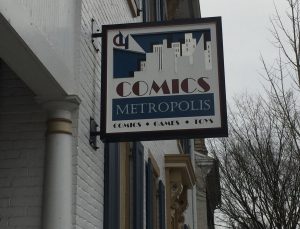
tal renovation, including specialized cabinets made for the comics they sold.
What’s inside the store is what draws people in. It can be a fireplace with collectibles on top of it, a Transformers collectible you’ve been waiting to purchase, or a copy of a comic you’ve been dying to get for ages. In The Sunwise Turn, customers were drawn into the store by the colors inside the store: “Orange is said to be the selling color, and so our walls were a burning orange, with all the other colors of the palette he made for us, woven through and up and down the windows and woodwork and floor. It was a ‘pot of paint flung into the face of the public,’ and the smiling little place made an immediate sensation” (Jenison 17-18). Comics Metropolis has its own way of being a sensation: its structure and homey-atmosphere. It’s a homelike place for the collector to come buy a new addition to their collection, a gaming center for roleplayers, or a bookstore open to find something new to read.
You ask Albert what advice he has on collecting. Then, he says, “Collect what you enjoy.”
To Laura, comics are intensely personal to both the author and the collector. When asked for her take on comics as literature, she had this to say: “Some of the best comic writers are ones who are able to exercise a lot of creativity in the way in which they structure their stories. … Sometimes [comics] start at the end and work their way backward. Within structure is where you really see the power of good writing come forth if you can be creative in a certain framework.” Comics offer more as a form than novels do, as they are able to combine the written word with bountiful illustrations, and those illustrations are bound to be personal, incorporating the artist’s own relationship with the characters they are drawing into the art itself.
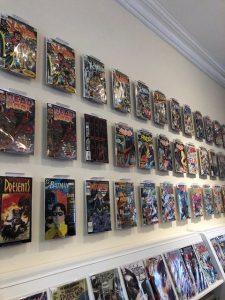
But it goes beyond that, still. Comics push the personal relationship between collector and collectable far past the bounds established by classic novel forms. Comics offer a physical look at the characters they are about, the worlds they are about, and then take those characters and replicate them in the real world as 3D models that you can collect, play with, manipulate, build your own narratives through. Comics extend off the page into the realm of action figures, board games, video games.
Throughout their history, comics have held a contentious place within the realm of literature. It is, in fact, one of the great literary arguments of the modern day: do comics offer enough to be considered in the realm of literature along works by such greats as Ernest Hemingway, James Joyce, and Jane Austen? There are certainly examples of comics with great social, cultural, and artistic impact: Maus by Art Spiegelman, for example, a graphic novel wielding powerful metaphor in its narrative detailing the harrowing experiences living as a Jew in Nazi Germany and the aftermath of the second World War.
Most—if not all—of the works we, as society, considered ‘great’ literature, or even just literature in its basest form, allow for some deeper personal connection with the story. Comics, too, offer a personal connection between readers and the written work, perhaps pushing this connection a step further outside of the bounds of the page. Comics Metropolis serves as a prime example of this.
As discussed previously, Comics Metropolis houses a large collection of comics paraphernalia. Comics do more than just function literarily as written stories. Comics, and the universes their writers and artists build, are unique for how far off the page those universes extend. Just take a look around the store in question: it’s a veritable treasure trove of all the different ways comics extend the definition of literature to encompass so much more than just the page.
Comics Metropolis was founded on the personal. We’ve seen how Albert and Laura Payne took their love of comics, and the different ways they were led to interact with them, and crafted that love into a physical place, a space packed full of personality and personal connections. If literature strives to forge deep personal connections between a reader and characters, then Comics Metropolis is a prime example of just how this is done, well exceeding the expectations and examples put forth by literary predecessors and even other bookstores.
Many comic book collections began with a few coins in the pocket of a kid, allowance or loose change scooped up from the street. Comics were affordable and entertaining, and like any good story, offered (and still do offer) an escape from the realities of the real world. Coming to prominence in the late 1930’s and rising ever higher in the ‘40’s, comics showed heroes doing the things Americans dreamed of; punching Hitler in the face, facing off against and beating insurmountable Nazi odds, and returning home victorious and lauded.
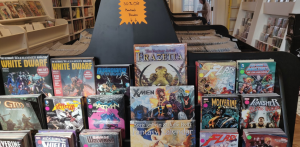
Comics offered, and continue to offer, an escape from the real world by superimposing exciting adventures over that same real world and allowing people to imagine themselves surrounded by heroes like Superman, Batman, and Spiderman. Because comics offer a dramatic reimagining (with images, no less) of the world that people are intimately familiar with, it allows readers to draw personal connections to the cities they live in that they get to experience heroes saving.
While it’s true that literature has always been a concept employed in the realm of books, comics have pushed boundaries throughout their frenzied existence. They offer more than classic literature can, because they make it possible to extend the definition of literature outside the page, to a whole host of other objects. Comics and collectibles are all about the personal, and if that’s what makes literature literature, than comics have exceeded this definition exponentially in a way no old white American man from the south probably ever thought was possible.
https://www.mhpbooks.com/watchmen-is-so-iconic-it-doesnt-need-a-title/
People collect things for a multiple reasons: to store cherished memories, enjoy a fun hobby, reduce anxiety or simply to showcase their belongings. The psychology of collecting is simple, and can be rephrased upon looking at Clifford’s “On Collecting Art and Culture”. This is where the study of anthropology aids the analysis of the collector, collection, and further in this case: literature.
According to Richard Handler, collections are “cultural property” because they encompass “arbitrary systems of value and meaning” that would usually be organized around one niche. In the case of Comic’s Metropolis, it’s comics; amongst comics related things. The store is based around the consumer’s collection as much as what the owner’s want as well. They purchase the stock, but items that consumer’s demand get added to the collection regardless of their place amongst everything else.
As with anything in nature, the object in question is always subject to outside variables that mold and change its contents. To put this into perspective, the bookstore is located in Lewisburg, PA, a Victorian town that requires eloquence, class, and cleanliness to get business. The next variable is the age and occupation bracket: a rather young and progressive college-town makes Data USA’s median age of 24.2 easily believable. The largest occupation demographic is education, training, and library occupations with 526 people out of a 1033 person census. This backs the success of the store, however it’s interesting that in a town with so many folks that work in libraries, the bookstore still makes a profit.
Nevertheless, maybe this has a greater and deeper connection to the lack of specified and careful appropriation of stock in a library versus the specialty of a bookstore. Speaking of specialty, that’s the magic of Comics Metropolis. They thrive off of being like none other, they are a niche market; unable to duplicated or bootlegged because the shop’s success is an extension of its specificity and premier condition.
Sources:
Clifford. “On Collecting Art and Culture”. Collections. Accessed 2019.
Jenison, Madge. Sunwise Turn: a Human Comedy of Bookselling. Booksellers House, 1993.
“Lewisburg, PA.” Data USA. https://datausa.io/profile/geo/lewisburg-pa/. Accessed 2019.
“Literature | Definition of Literature in English by Oxford Dictionaries.” Oxford Dictionaries |
English, Oxford Dictionaries, en.oxforddictionaries.com/definition/literature.
“The Poetry Path.” Jean Valentine | Poetry Path Site 4 | Stadler Center for Poetry & Literary Arts
| Bucknell University, www.bucknell.edu/info-about-attending-bucknell/academics-at-bucknell/academic-centers-and-institutes/stadler-center-for-poetry-and-literary-arts/poetry-path/poetry-path-poems-and-poets/site-4-churches.html.

0 Comments